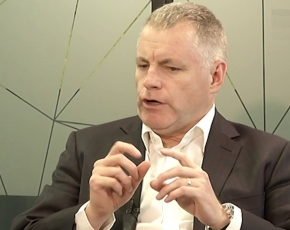
Sappi Reports Results for Its Second Financial Quarter Ended March 2019 "Solid containerboard demand and a recovery of consumer packaging were offset by continued weakness in the self-adhesives and release paper segments." – Steve Binnie, CEO, Sappi Limited.
"Solid containerboard demand and a recovery of consumer packaging were offset by continued weakness in the self-adhesives and release paper segments." – Steve Binnie, CEO, Sappi Limited.
May 10, 2019 - Sappi Limited yesterday reported the following financial summary for the company's second financial quarter ended March 2019: Commenting on the result, Sappi Chief Executive Officer Steve Binnie said, “The business continued to be supported by the investments made in recent years to diversify the product portfolio with packaging and specialities sales volumes for the group up 18% and dissolving wood pulp (DWP) increasing by 16% year-on-year. However, graphic paper markets were much weaker than expected due to an economic slowdown and the impact from selling prices implemented last year. “Demand from our major DWP customers remained healthy. Solid containerboard demand and a recovery of consumer packaging were offset by continued weakness in the self-adhesives and release paper segments.” Demand in our major graphic paper product categories was down between 8% and 13% in Europe and North America. We were thus compelled to take production downtime of 85,000 tons across our paper machines in these regions. DWP sales volumes increased following the debottlenecking of the Saiccor and Ngodwana mills in the past year, and a strong operating performance from the DWP mills. In Europe, packaging and specialities volumes increased by 25% compared to a year ago due to the ramp-up of the Maastricht mill conversion and the benefit of a full quarter of Cham paper volumes. The ramp-up of Sappi North America's Somerset mill (Maine) PM1 paperboard grades continued with sales volumes 68% higher than the prior quarter. These markets require complex and lengthy qualification processes. The South African business delivered another excellent performance, with increased DWP sales volumes and higher average net selling prices for all major product categories offsetting higher energy and fibre cost pressures. Raw material costs, in particular pulp, energy, wood and chemical costs continued to be elevated. Looking towards the rest of the year, Binnie indicated that "in support of our transition to growing and higher margin segments, capital expenditure for the remainder of 2019 is expected to be approximately US$370 million. The major projects included are the recently completed pulp mill debottlecking at Cloquet (Minnesota) as well as the ongoing 110kt Saiccor mill expansion and Lanaken PM8 conversion from coated mechanical to coated woodfree paper production projects." He concluded by saying that "Given the current weak market conditions for graphic paper, DWP pricing pressure from oversupplied VSF markets and our more conservative outlook on the global economy, the second half and full year profitability are now expected to be below that of last year." OutlookDissolving wood pulp demand from our major customers remains healthy. The expanded production capacity, following the debottlenecking of Saiccor and Ngodwana in 2018, remains fully sold. Our DWP contract sales prices lag Chinese market prices by a quarter and therefore the decline in market prices over the past few months along with planned maintenance downtime at all three of our DWP mills will impact margins and profitability in the third quarter. Packaging and speciality markets, with the exception of release and self-adhesive papers, are growing. Raw material prices remain a concern for non-integrated mills, however pulp and chemical costs have started to decline recently. The ramp-up and product mix optimisation process continues at Somerset and Maastricht as qualification and customer acceptance work is completed. Demand for South African packaging products is expected to be strong. Graphic paper markets remain weak, and despite expected closures or conversions by competitors, it may take the remainder of the calendar year before sufficient capacity is removed to allow operating rates and margins to recover. Some relief may be expected from lower input costs going forward as paper pulp and some chemical prices have reduced in recent months. The conversion of Lanaken PM8 to coated woodfree from coated mechanical will be completed during the third quarter, with some negative impact on production and fixed costs due to machine downtime in the interim. The full results announcement is available at www.sappi.com. About Sappi LimitedHeadquartered in Johannesburg, South Africa, Sappi is a global leader in paper, paper pulp and dissolving wood pulp solutions. The company has over 12,000 employees; manufacturing operations on three continents, in seven countries (nine mills in Europe, three mills in America and four mills in South Africa) and customers in over 150 countries worldwide. In FY2018 Sappi produced approximately: 5.7 million tons of printing and writing, speciality and packaging paper; 2.3 million tons of paper pulp, and 1.4 million tons of dissolving wood pulp. The company continues to invest in developing biomaterials (nanocellulose, fibre composites and lignosulphonate) and biorefinery (second generation sugars and bio-energy) businesses. To learn more, please visit: www.sappi.com. SOURCE: Sappi Limited |